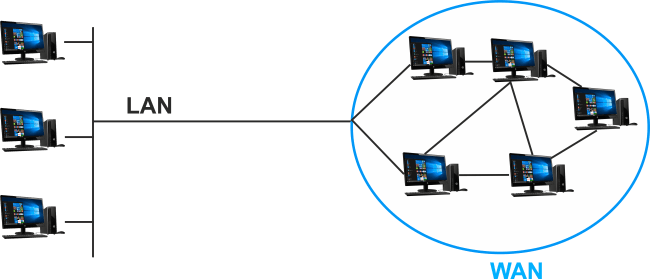What is the Full Form of WANWAN: Wide Area NetworkWAN stands for Wide Area Network. It is a network that made its presence globally very soon. It can be utilized to connect multiple devices all over the world. This type of network provides a better facility to communicate between devices in any part of the world. Nowadays, the internet is recognized as the world's most extensive and fastest-growing wide area network, making connectivity easier among people worldwide. WAN is very much helpful in building communication in communities, businesses and organizations. A wide area network is a typical form of a telecommunication network that can be used through any location across the world, and that's why it is known as the most prominent computer or system network available globally today. 
Simply put, a Wide Area Network is a network of multiple device connections established through Local Area Networks or other networks that can communicate with each other over large distances. WANs are essentially networks of networks, with the Internet serving as the most extensive WAN on the planet. The wide area networks are provided with the help of service providers. For instance, the service providers in the case of SIM and cellular networks include vendors like JIO, IDEA, AIRTEL, VI, etc. They typically charge users for giving access to their networks. Customers can send or receive messages from anywhere to any location if they are within the network range of the service provider. One of the best things about Wide Area Network is that it provides better security than other networks, providing a unique IP address to each device connected to it. An IP address is recognized as an identity of the network and is logged for every data transaction. It is typically used by a service provider to locate a specific device. A Wide Area Network is mainly of two types. The first is based on a point-to-point connection, and the second operates by transferring data packets. A WAN router is needed for building this network, which is also known as an edge router or border router. A WAN router is a device that is used to connect the devices that provide a path for transferring data packets between the wide area network locations and allowing access to a carrier network for a business. Brief History of the Wide Area NetworkIn the late 1950s, the Wide Area Network was first designed by the U.S. Air force. The primary roots of the huge area network are connected to the United States defence in which they developed the ARPANET, and with the help of it, significant researchers could communicate and share computer resources remotely. The link was made via radio waves, circuit-switched telephone lines, or optical fibres. Since then, it has evolved greatly and proved effective in the interchange of data worldwide among people. These networks are now helping to establish communication between a client and an employee, a teacher and a student, a buyer and a seller, etc. An important advantage of a Wide Area Network is that it can transmit images, audio, video and many other digital formats over long distances. WAN OptimizationPerformance challenges in businesses are often caused by latency and bandwidth concerns in the network. Wide Area Network uses best optimization practices with the help of various techniques, including network shaping, protocol optimization, reduction, compression and local cache. With the help of these techniques, the network is improved, and packet delivery is optimized. This ultimately helps to control traffic laterally and enable dynamic network bandwidth growth or contraction as needed. Characteristics of a Wide Area Network
Advantages of Wide Area Network
Disadvantages of Wide Area Network
Types of WAN Technologies
Next TopicFull Form
|
 For Videos Join Our Youtube Channel: Join Now
For Videos Join Our Youtube Channel: Join Now
Feedback
- Send your Feedback to [email protected]
Help Others, Please Share










